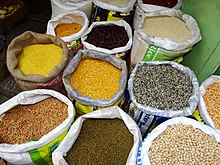**Legume Terminology and Classification:**
– The term ‘pulse’ is reserved for legume crops harvested solely for the dry seed by the FAO.
– Excluded from pulses are green beans, green peas, oilseeds like soybeans and peanuts, and seeds used exclusively for sowing forage.
– Common usage blurs these distinctions, with some varieties used for both dried pulses and green vegetables.
– Some leguminous plants like Scotch broom are not referred to as legumes by farmers.
– Legume crops are typically considered food crops.
– Legumes are the third-largest land plant family with about 19,000 known species.
– They constitute about 7% of flowering plant species.
– Legumes are widely distributed, with approximately 751 genera.
– Orchidaceae and Asteraceae are the only plant families with more species than legumes.
– Legumes play a significant role in the plant kingdom due to their diversity and distribution.
**Historical Significance and Evolution of Legumes:**
– Neanderthals used pulses in meals 70,000 years ago.
– Evidence of pulse production dates back to 3300 BC in the Indus Valley civilization and in Egyptian pyramids.
– Soybeans were domesticated in China around 5,000 years ago and introduced to the US in 1770.
– Henry Ford played a significant role in developing the domestic soybean oil industry in the US.
– Between 1970 and 1976, soybean production increased by approximately 30%.
**Uses and Benefits of Legumes:**
– Cultivated legumes serve various agricultural purposes including forage, grain, pharmaceutical/industrial, and timber categories.
– Legumes like beans, lentils, lupins, peas, and peanuts are used for human and animal consumption and industrial oil production.
– Legumes are increasingly used in vegan meat and dairy substitutes as a plant-based protein source.
– Legume products saw a 39% growth in Europe between 2013 and 2017.
– Legumes are rich sources of protein, dietary fiber, carbohydrates, and dietary minerals.
– Legumes like chickpeas provide significant amounts of protein, fiber, folate, and manganese.
– Legumes are a good source of resistant starch, which is beneficial for intestinal health.
**Agricultural and Environmental Impact of Legumes:**
– Forage legumes like alfalfa and clover are grazed by livestock, improving animal performance.
– Legume trees like Gliricidia sepium provide shade for cattle and are consumed by them.
– Legumes can be grown between economic crops as green manure.
– Legumes contribute nitrogen to the soil through root nodules, serving as a natural fertilizer for future crops.
– Legumes play a crucial role in the nitrogen cycle, benefiting soil fertility.
**Challenges and Research in Legume Industry:**
– Seed viability decreases with longer storage time.
– Relative humidity and temperature influence germination.
– Pests such as bean flies, black bean aphids, pea weevil, and stem nematodes pose threats to legume crops.
– The International Year of Pulses in 2016 aimed to raise awareness of the nutritional benefits of pulses for food security and promote pulse-based proteins.
– Research and development initiatives focus on improving crop yields, processing techniques, and pest control for legumes.
Legumes (/ˈlɛɡjuːm, ləˈɡjuːm/) are plants in the family Fabaceae (or Leguminosae), or the fruit or seeds of such plants. When used as a dry grain for human consumption, the seeds are also called pulses. Legumes are grown agriculturally, primarily for human consumption; for livestock forage and silage; and as soil-enhancing green manure. Well-known legumes include beans, soybeans, chickpeas, peanuts, lentils, lupins, grass peas, mesquite, carob, tamarind, alfalfa, and clover. Legumes produce a botanically unique type of fruit – a simple dry fruit that develops from a simple carpel and usually dehisces (opens along a seam) on two sides.


Legumes are notable in that most of them have symbiotic nitrogen-fixing bacteria in structures called root nodules. For that reason, they play a key role in crop rotation.
